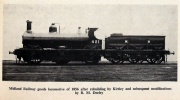Richard Mountford Deeley


Richard Mountford Deeley (24 October 1855-19 June 1944) was a British engineer, chiefly noted for his five years as Chief Mechanical Engineer (CME) of the Midland Railway.
Richard Deeley is recorded as being was born in Derby although census returns indicate that he was born in Chester.
His father had been an accountant with the Midland Railway and Richard attended grammar school in Chester.
of 10 Charnwood Street, Derby (1897). [1]
In 1873 he became a pupil of B. Ellington at the Hydraulic Engineering Co in Chester,
1875 He became a pupil of Samuel Waite Johnson at the Derby Works.
In March 1890 he became chief of the testing department at Derby, then progressed to the position of Inspector of Boilers, Engines and Machinery (March 1893), and to Derby Works Manager in January 1902, adding the post of Electrical Engineer a year later.
In July 1903 he also became Assistant Locomotive Superintendent, subsequently replacing Johnson as Locomotive Superintendent on 1st January 1904. He made significant contributions to compounding, adopting Smith's system for his Midland Compound 4-4-0 locomotives. However, the refusal of the company's board to sanction development of larger locomotives, and friction with the new senior managers, led him to resign his post at the end of 1909.
After this he continued to work and publish on engineering problems in both railway and non-railway applications.
1945 Obituary [2]
RICHARD MOUNTFORD DEELEY, whose death occurred on 19th June 1944, at the great age of 89, was in former days well known in locomotive engineering circles and will be remembered for his successful exploitation of the compound locomotive on the Midland Railway system, with which he was closely identified during practically the whole of his professional career. He had been a Member of the Institution for over half a century, having been elected in 1890. He was also a Member of the Institution of Civil Engineers.
After receiving his general education at the Chester Cathedral Grammar School he entered, in 1873, the works of the Hydraulic Engineering Company, of Chester, as a pupil; two years later he went to Derby to serve a further term of pupilage under Mr. Johnson, at that time locomotive superintendent of the Midland Railway, under whom he gained practical experience in the pattern, fitting, and erecting shops. His aptitude for experimental work led at an early age to his appointment as chief of the testing department.
In 1893 he was appointed inspector of locomotives and after holding this position for six years was entrusted with the supervision also of all electric plant on the system; but he retained his connection with experimental work until 1902 when he became manager of the locomotive works. On the retirement of Mr. Johnson in 1903 he entered upon his final position as chief locomotive superintendent and mechanical engineer, retaining that appointment until his retirement in 1909. During his tenure of office Mr. Deeley, in addition to his development of the compound locomotive was responsible for a number of other new designs and furthermore collaborated with Mr. Leonard Archbutt, chief chemist of the Midland Railway, in the design and construction of water-softening plant. But it was in the field of lubricants that he established a reputation, and his textbook "Lubrication and Lubricants" published in 1898 is still regarded as a standard work of reference.
In this connection his invention of an ingenious apparatus for testing the "oiliness" of lubricants formed the subject of a communication to the Physical Society in 1909 and was also described in a report to the Lubrication Research Committee of the Department of Scientific and Industrial Research.
See Also
Sources of Information
- ↑ The Engineer 1897/02/26
- ↑ 1945 Institution of Mechanical Engineers: Obituaries

